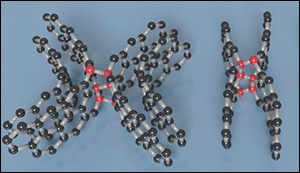New Form of Carbon That's Hard as Rock and Elastic Like Rubber
12. 6. 2017 | Carnegie Science | carnegiescience.edu
A team including several Carnegie scientists has developed a form of ultrastrong, lightweight carbon that is also elastic and electrically conductive. A material with such a unique combination of properties could serve a wide variety of applications from aerospace engineering to military armor.
Carbon is an element of seemingly infinite possibilities. This is because the configuration of its electrons allows for numerous self-bonding combinations that give rise to a range of materials with varying properties. For example, transparent, superhard diamonds, and opaque graphite, which is used for both pencils and industrial lubricant, are comprised solely of carbon.

In this international collaboration between Yanshan University and Carnegie, scientists pressurized and heated a structurally disordered form of carbon called glassy carbon. The glassy carbon starting material was brought to about 250,000 times normal atmospheric pressure and heated to approximately 1,800 degrees Fahrenheit to create the new strong and elastic carbon.
Read more at Carnegie Science
Image Credit: Carnegie Science
-jk-




